
I spend lot of time trying to decipher almost illegible scrawls inscribed on the back of old photographs, often the only clue to the subject matter of the image on the front. Quite frequently, it comes down to whether a flick of the pen was the start of a new letter or part of the previous one. There's not much point in dwelling on the matter of whether a little more care could have been taken at the time. You just get on with it and work with what you have.

Six years ago a tattered and threadbare velvet-covered album of family photographs came into my possession, having originally been purchased at a yard sale in eastern Pennsylvania. Jack Armstrong had intended to research it himself, but after several years the almost total lack of any clues left its origins as mysterious as when he bought it.
A number of the portraits in the album had been taken by studios in Derbyshire (England) - hence my interest - but all provenance had been lost, and clues to the identity of the subjects were almost completely non-existent. I subsequently used the album as a photo-archival exercise, with several articles published here on the standard photographing, scanning and documentation procedures that I use for such projects (here, here and here). I also used a photograph from the album as the introductory image for a Sepia Saturday article (SS 170) that I wrote about gamekeepers.

Geographical distribution of photographs (click image to enlarge)
In addition to scanning and documenting the collection, I also did some geographical analysis of the studios at which the portraits were taken. As shown in the pie chart above most of the 55 portraits were taken in the United Kingdom, and of those the majority came from Derbyshire (10) and Staffordshire (9). In the United States the bulk of the portraits were taken in Cleveland, Ohio (8).
My initial analysis suggested, therefore, that the family which owned the album may have emigrated from one of several locations in Staffordshire or Derbyshire to Cleveland, Ohio at some time within the date range of the portraits in the album.

Dates of portrait sittings (click image to enlarge)
N.B. 5-yr moving average of mid-points of date estimates
I then constructed a graph showing the frequency of portrait sittings over time, using five year moving averages of the mid-points of the estimated date ranges. I realise that the logic and methodology of using five-year moving averages to represent date range estimates is a bit dodgy, to say the least, and I have since revised my date estimates for several photos, but I hoped that this would smooth out the graphs and at least give an an overall visual impression of the main periods that the images were taken, which it does fairly well.
The graph (or chart, if you prefer) demonstrates that the US photos start to appear in the early 1880s, while from the early 1890s onwards, the preponderance of UK photos diminishes markedly. To me this suggests an immigration date range from the early 1880s to the early 1890s. It is conceivable that one part of the family immigrated to the US in the early 1880s, while a second part arrived in the early 1890s. This could have been a husband and wife's family arriving at different times, or indeed something far more complicated.
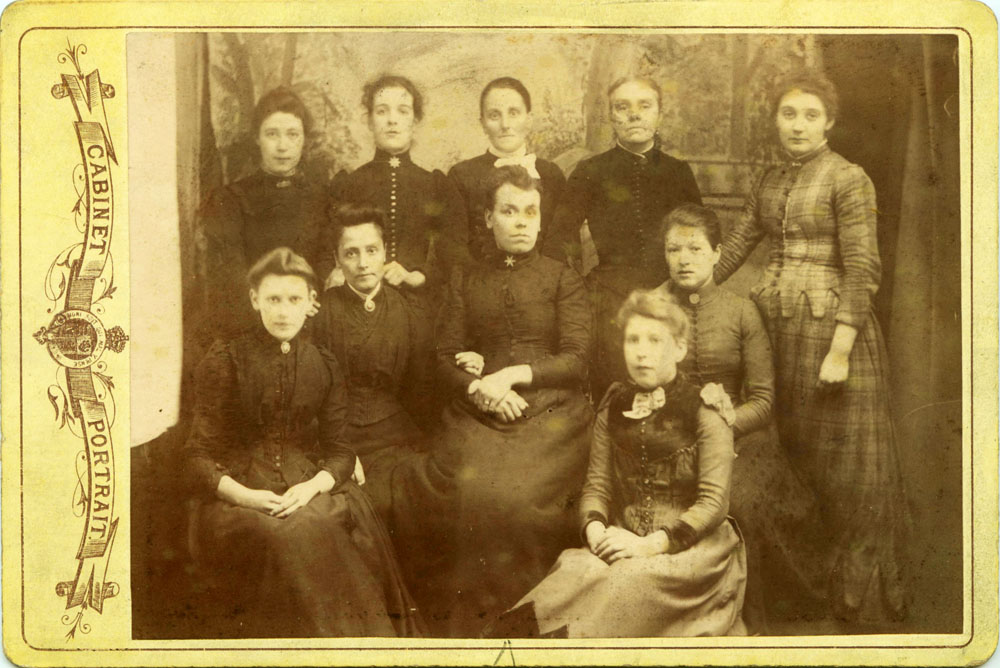
Cabinet portrait of unidentified group of women, c.1889-1893
Image © and collection of Brett Payne
There are very few inscriptions on the photographs, and none at all on the album pages. The only one that appears to offer any immediate clues to the identity of the subjects is on the back of a cabinet portrait of a large group of ten women taken in the very late 1880s or early 1890s by a professional, if somewhat hastily put together, studio. It has been mounted onto a standard cabinet card mount with no photographer's name, although the presence of a royal seal in the scroll work design strongly implies a United Kingdom origin.
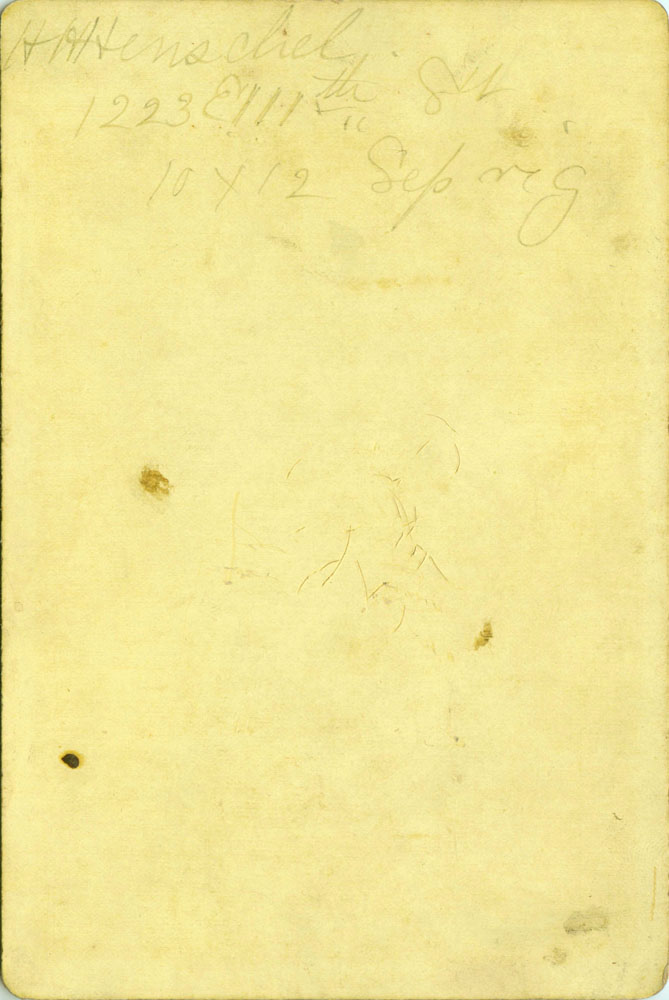
Inscription on reverse of cabinet card mount
The text, handwritten in pencil, appears to read as follows:
H.H. HenschelThe first line is almost certainly a name, H.H. Henschel or conceivably "Herschel," and is probably the client's name, not necessarily that of the subject. The second line, I think, comprises an address, (number) 1223 East 111th Street, while the third I have deciphered as instructions for a copy enlargement of the portrait to be made, 10" x 12" Sepia vignette. At the edge of the front of the card mount is a small arrow marked in pen or pencil indicating that the central figure is the one which is to be enlarged.
1223 E 111th St
10 x 12 Sep vig
The surname appears to be of Germanic origin, and the address is in a style more likely to have originated in the United States than in the United Kingdom. I came to the conclusion, therefore, that although the original portrait had been taken somewhere in the UK, the vignetted portrait enlargement was requested by someone who no longer had access to the original studio negatives. In other words, it may have been written, and therefore the enlargement made, some years after the original portrait had been taken. It could have been a simple framed vignette or a much more elaborate glazed and framed, colourised portrait, examples of which I have posted here and, with my Tauranga Historical Society hat on, here.

Census enumeration for 1221 E 111th St, Cleveland City, 23 Apr 1910
Image © The National Archives & courtesy of Ancestry.com
Given that Cleveland, Ohio features so prominently in the US portraits, I searched for the surname "Henschel" in census records for that city. Almost immediately I came up with the following spectacular discovery at 1221 East 111th Street, Cleveland in 1910:
Gifford Frederick / Head / 48 / Widr / b Eng / Imm 1892 / China Artist
Gifford Frederick J / Son / 10 / S / b OH
Henschel Herbert / SoninLaw / 23 / M 2y / b OH / Auto Co. Electrician
Henschel Agnes H / Dau / 22 / M 2y / b Eng
Henschel Herbert G / GdSon / 11m / S / b OH
Here was a family that fitted the bill, having arrived in the United States in 1892, settled in Cleveland, with a daughter who married Herbert Henschel in about 1908, and were living at in East 111th Street in 1910 - although at number 1221 instead of 1223. It seemed almost too good to be true but, as I investigated the family further through census records and the discovery of online family trees, pieces continued to fall into place.

The Henschel family arrived on S.S. Cimbria in 1881
Image courtesy of Ancestry.com
Wilhelm (William) Henschel and his family emigrated from Berlin, Prussia in 1881. After a fifteen day voyage across the North Atlantic on board the Hamburg America Line steamship Cimbria, his wife Wilhelmina (Minnie) and three children arrived in New York on 6 October and joined William in Cleveland, Ohio.

Garfield Monument, Cleveland, Ohio, taken c. May 1890
Cabinet card by unknown photographer
Image © and collection of Brett Payne
Having arrived in the United States only a few weeks after the assassination of President Garfield, whose home town was Cleveland, it was natural that when a monument to him was unveiled at the Lake View Cemetery in Cleveland and dedicated in May 1890, the Henschel family should preserve a keepsake of such an historic occasion in their family album.
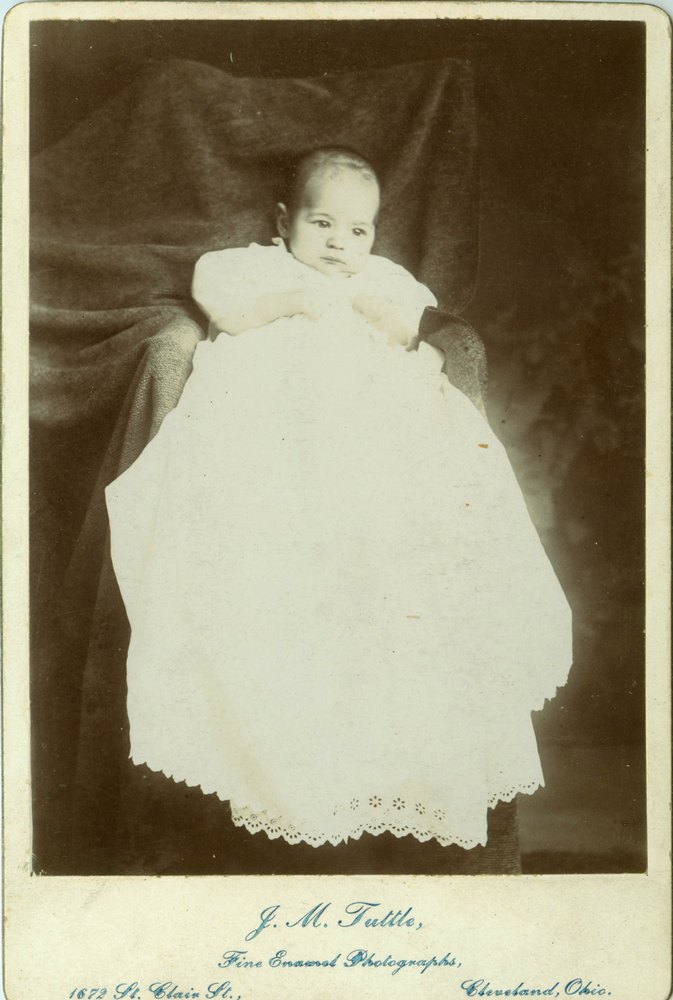
Unidentified child in christening gown, c.1889-1892
Cabinet card by J.M. Tuttle, 1672 St Clair St, Cleveland, Ohio
Image © and collection of Brett Payne
In the mean time, the Henschel family had grown. A fourth son William was born in September 1884 and a fifth Herbert Henry Henschel on 24 June 1888, nearly seven years after settling in Cleveland. Their only daughter Mamie arrived in July 1891. This baby in a christening gown could be either Herbert Henry or Mamie.
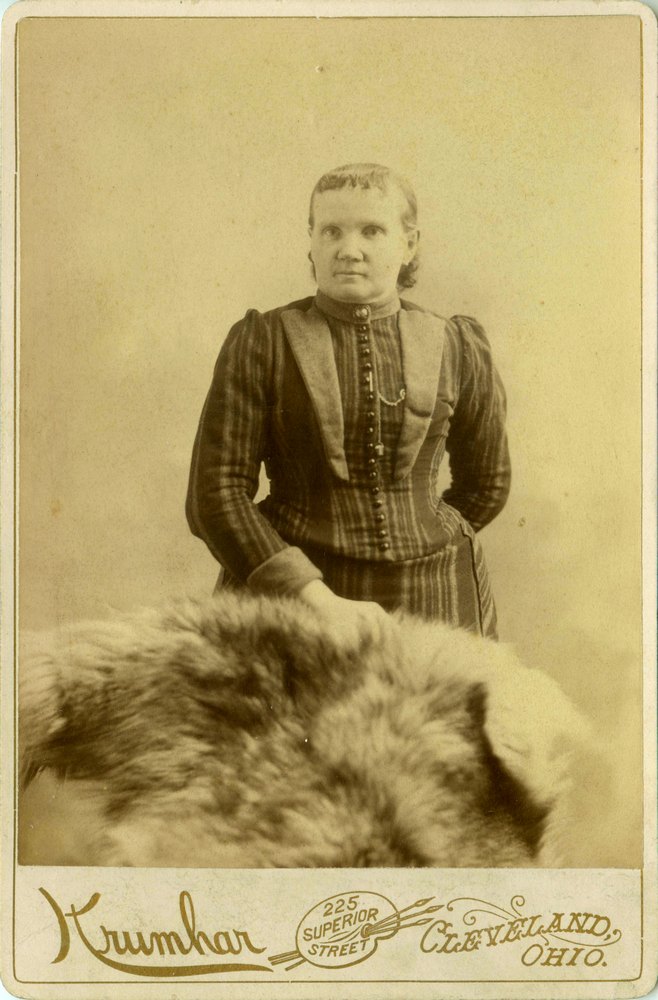
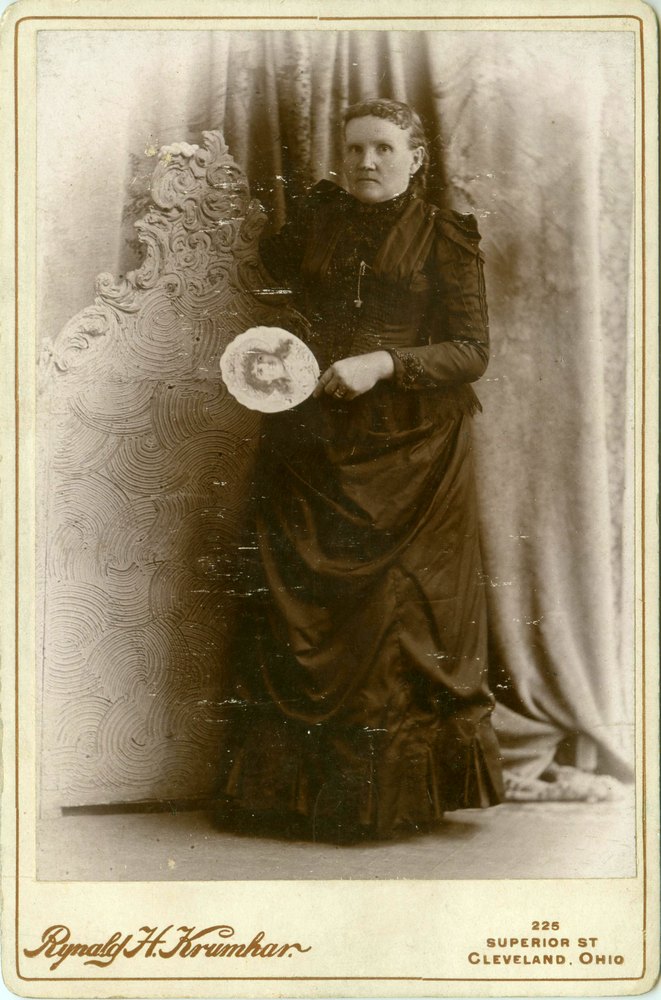
Unidentified woman, taken c.1891-1892 (click images to enlarge)
Cabinet cards by Rynald H. Krumhar, 225 Superior St, Cleveland, Ohio
Image © and collection of Brett Payne
The two portraits of a middle-aged woman with a very close-fitting hair style and almost as severe an expression were taken by Rynald H. Krumhar who, according to Artists in Ohio, 1787-1900: A Biographical Dictionary, operated a studio in Cleveland on his own in 1891 and 1892 before teaming up with his brother Robert F. Krumhar between 1892 and 1895. Minnie Henschel (1848-) was in her early forties at the time these two portaits were taken, and I believe must be the prime candidate.
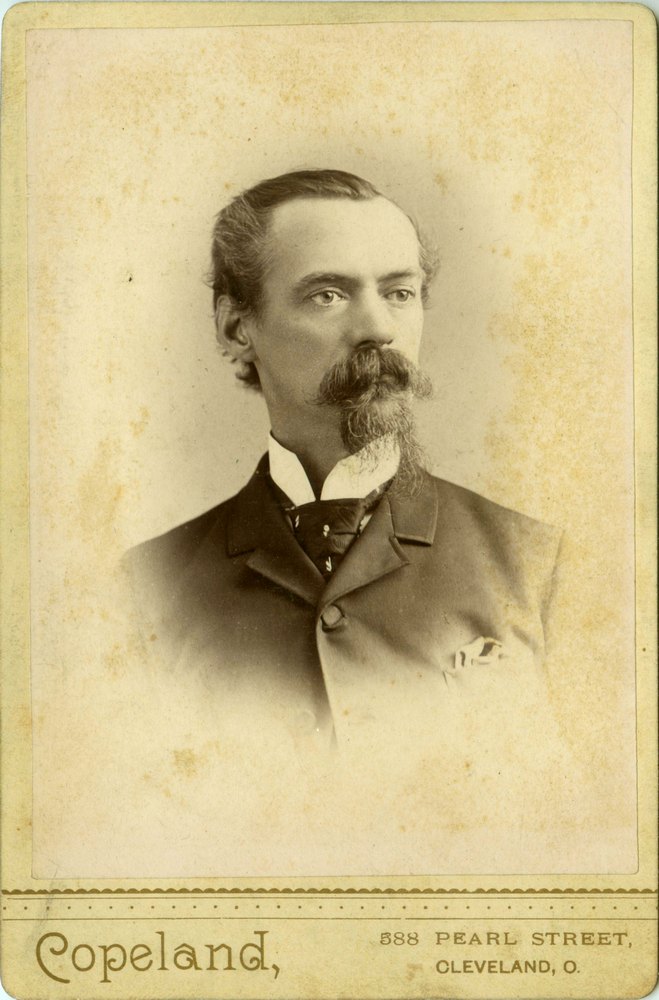
Unidentified man, taken c. 1887-1892
Cabinet card by Copeland, 588 Pearl Street, Cleveland, Ohio
Image © and collection of Brett Payne
A head and shoulders vignetted portrait of a similarly aged gentleman with a luxuriant moustache and goatee may have been taken slightly earlier. I don't have dates of operation of the Cleveland photographer Copeland, but from the style of mount, portrait and clothing I suspect it dates to the late 1880s or early 1890s. William Henschel Sr. (1850-) is the obvious choice here, as he too would have been about 40 years old.

Unidentified young man, taken c. 1894-1897
Cabinet card by Pifer & Becker Photo-Palace, Wilshire Building, 94-100 Superior St, Cleveland, Ohio
Image © and collection of Brett Payne
This young man appears to be aged in his late teens, and probably visited Pifer & Becker's Photo-Palace studio in the mid-1890s. I suspect that it is one of Herbert's older brothers, Max, Hugo or Fred, all of whom were born in Germany.
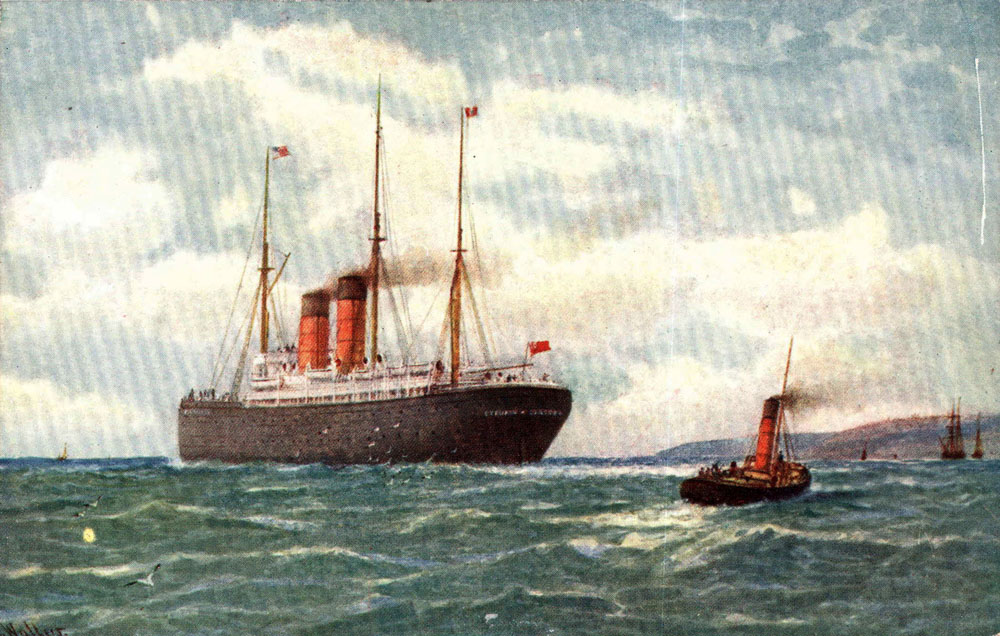

Passenger manifest for S.S. Etruria, arr. New York 27 Feb 1893
On 27 February 1893 Frederick Thomas Gifford (1862-1932) and his wife Ellen arrived at Ellis Island, New York on board the SS Etruria from Liverpool, England with their four year old daughter Agnes Hammersley Gifford (1888-1967), giving Cleveland, Ohio as their destination on the ship's manifest.
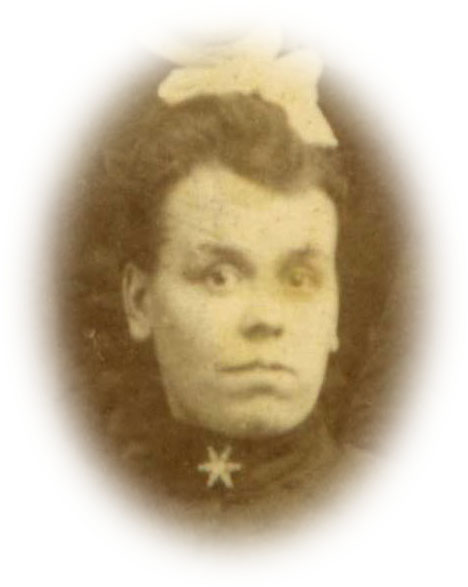
Vignette of unidentified woman marked on cabinet card
Frederick Thomas and Ellen Gifford had a son, also named Frederick, born in Cleveland in July 1899. Their daughter Agnes married Herbert Henschel in Hutchinson, Kansas in February 1907. Ellen Gifford died in April 1908 at 1221 East 111st Street, Cleveland, and was buried at Lakeview Cemetery. It was to this same address that the vignetted portrait enlargement - perhaps looking something like the image I created in Photoshop, above - was sent.
We also know that the widowed Fred Gifford, his son and the Henschel family were living there in 1910. By February 1913, when Herbert and Agnes' second child was born, the Henschels had moved to Indiana. It seems a distinct possibility, therefore, that the enlargement is of Agnes's mother Ellen Gifford (1866-1908), and that it was commissioned some time in the five years between her death in April 1908 and their arrival in Indiana in February 1913.

Unidentified child, taken c. 1892-1895
Carte de visite by Krumhar Bros., 225 Superior St, Cleveland, Ohio
Image © and collection of Brett Payne
When this warmly dressed child visited the Krumhar studio on Cleveland's Superior Street both of the Krumhar brothers were in attendance, dating it to between 1892 and 1895. Probably aged between 7 and 9 years old, and I'm guessing a girl because a boy is unlikely to be in a dress at that age, my estimate is that she would have been born circa 1883-1888. I believe this could be be Agnes H. Gifford.
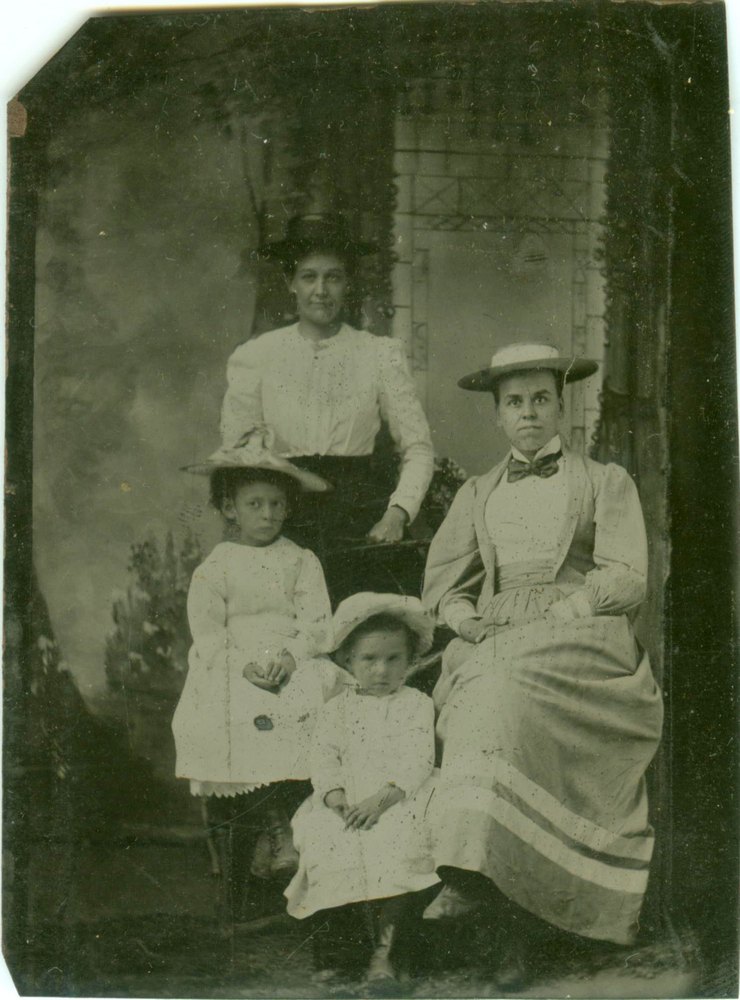
Unidentified group of 2 women & 2 children, taken c. 1892-1895
Sixth-plate tintype (63 x 84mm) by unidentified photographer
Image © and collection of Brett Payne
Inserted within the album are three loose, roughly trimmed sixth-plate tintypes, all taken in studio settings but without any indication of location. The clothing worn by the two women in this group portrait suggests they were taken in the early to mid-1890s, a time when the tintype was far more popular in North America than in England. The woman from the vignette appears seated on the right, wearing a broad-brimmed light-coloured hat, while the child from the Krumhar Bros. portrait is seated at left, also with a very flat hat. Are these two Ellen Gifford and her daughter Agnes? I think so, but then who might the other woman and younger child be?

The Gifford family at 125 Becker Av, Cleveland City, 13 June 1900
The answer to the identity of the other child may lie in the 1900 Census record, which shows the Gifford family living at 125 Becker Avenue, Cleveland. In addition to (Frederick) Thomas, Ellen and Agnes, their ten month-old son Frederick J. is shown as having born in July 1899, probably too late to be the younger child in the tintype portrait. However, from the figures in the columns to the right of her age (Married for 13 years, Mother of 4 children, of which 2 living), we can infer that Ellen had two further children who died young. The younger child could be one of those who died, or alternatively belongs to the other woman who is standing at the back.
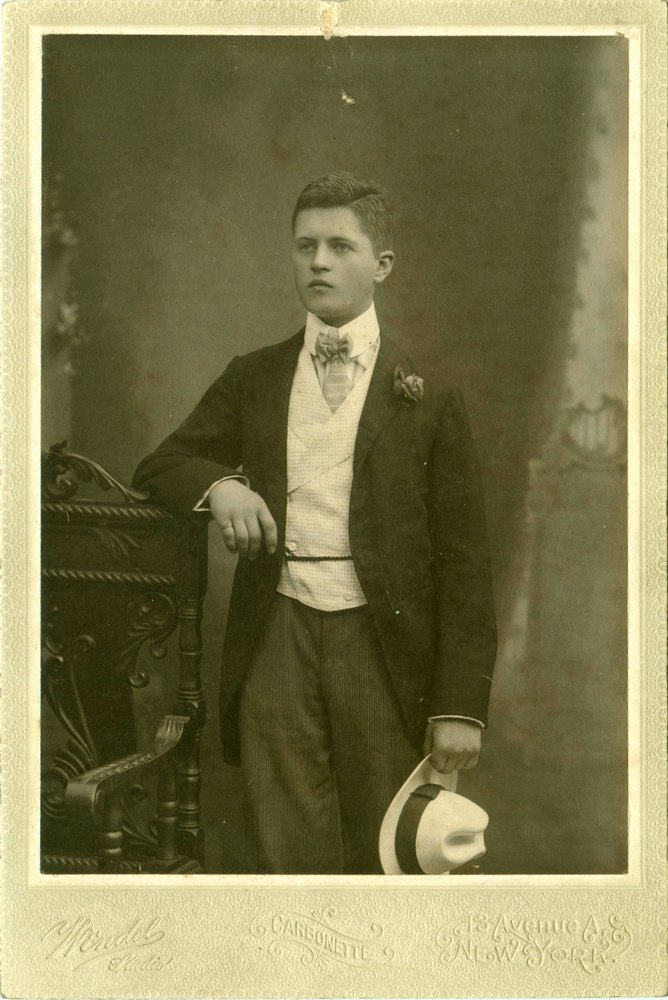
Unidentified young man, taken c. 1915-1925
Cabinet card (Carbonette) by Wendel Studio, 13 Avenue A, New York
Image © and collection of Brett Payne
This very smartly dressed young man with a bowtie, fedora and a rose in his buttonhole probably visited the Wendel Studio in New York for a portrait in the late 1920s or early 1920s. He looks to me to be in his late teens, perhaps between 17 and 20 years old, so I estimate that he was born c.1895-1908. The birth date of Frederick J. Gifford (1899-1959) lies well within this range; he married in 1930 and died at Jamestown, New York in November 1959. His father had also died at Jamestown in 1932.

Card mount (114 x 182mm) with no photograph, c.1910-1925
By the Globe Photo Co., 309 Main St., Jamestown, N.Y.
Image © and collection of Brett Payne
My last image for the moment is, in fact, not a photograph at all. This card mount from the Globe Photo Co. studio in Jamestown, New York has lost its contents, so we may never know whose face was framed within it. However I believe that it probably originally contained a postcard format portrait, and the style of mount suggests to me a date of perhaps the 1910s or early 1920s. I found several postcard format portraits from this studio on the web, and they come from a similar era.

I have no doubt that at this point several readers will be thinking that I have amassed a good deal of circumstantial evidence, and may even have indulged in a fair amount of speculation, but have presented little in the way of proof except for the single inscription. To my mind that inscription, and more specifically the juxtaposition of name and address, establishes the connection between that particular portrait and the Henschel-Gifford family without a doubt.
From that point, I agree that I'm on much more shaky ground, but I hope you'll bear with me as I continue to build up a family tree, and attempt to link portraits to individuals within that tree. Part of the difficulty is that one has to not only populate the family tree, but also show that individuals were in the right place at the right time to have their portraits taken. It's a lengthy and time consuming exercise to unravel the complex family relationships, which I'll have to spread over several articles in due course. Next week I'll turn to the English side of the family and look at portraits from Derbyshire and Staffordshire.








This is so thorough, so careful, and most of all, so inventive!
ReplyDeleteI am on tenterhooks to see the results of your search for living descendants!
Thanks, Jack. I'm grateful for the opportunity to research the album.
DeleteYay for tracing the Henshall-Gifford family tree from just photos. You are a great sleuth! Watch out Sherlock!!
ReplyDeleteBarbara - More in store next week.
DeleteAll I can say is "Whew!" How on earth do you find time for hiking between all the sleuthing?!! Very good job, though. You certainly get extra credit! :)
ReplyDeleteGail - As with many of my photohistorical projects, this one has been on the slow burner for several years. I just happened to look at it again last week, and bang, there was the census record which provided the vital clue, and then I was away. Yes, it's time consuming.
DeleteTime consuming it may be, but if it's something you enjoy doing, it's worth it - something I occasionally have to remind myself when I feel I may be spending too much time on certain projects - like Sepia Saturday. :) But, oh well. It's fun & so what!
DeleteSuch amazing research. We're in London at the moment and I can see Scotland Yard from my window. How fitting a setting for reading this.
ReplyDeleteHelen - A perfect setting. Enjoy the rest of your holiday.
DeleteGreat research!
ReplyDeleteThanks, Postcardy.
DeleteOh Brett I do enjoy reading your posts and seeing the fruits of your research. I really like how you popped the image of the manifest under the image of the SS Etruria too - nicely done.
ReplyDeleteThanks, Alex. I always look for images of the ships my own family travelled on when they travelled, and it helps to give a sense of the adventure and trepidation which they must have experienced.
DeleteI really enjoyed the research journey. I find it hard sometimes to pause and document the process because I am so eager pursuing the next leads. I look forward to the next installment.
ReplyDeleteMe too, Anne, but eventually we have to share our research.
DeleteA masterful demonstration of logic and deduction, Brett. The evidence may be slim but you have linked it together so neatly that the family relationships come to life.
ReplyDeleteIt's amazing how many tools are now available on the internet for solving puzzles like this that only a few years ago would have been impossible. Just this week, I uncovered the clues to identify a man in an 1890s cabinet card from Sydney using an Australian newspaper archive, and then tracked him to London in the 1901 UK census. I never imagined that solving the mysteries in antique photographs would be so much fun.
Mike - What would we do without Ancestry.com amd similar databases? Well, not a fraction of this, I suppose. Intercontinental sleuthing has become staggeringly easy, and I've been able to track down people who've emigrated or done a runner in just the same way.
DeleteGood logic, Brett! You can research something to death, but sometimes you have to take a leap of faith, assume something, and then go on to prove/disprove. I buy things in flea markets that have some form of identification, track down descendants through ancestry and then mail to relatives...it's extremely rewarding to figure out who's who, and, finally, to be able to mail a portrait of somebody's great aunt Isabelle back to a family member!
ReplyDeleteGood for you, Deb. Hopefully I'll be able to find a living descendant or two as well.
DeleteI hope someone researching this family finds your post and gets in touch. I find myself going off on research trails for friends of my grandparents. I've got one I researched that I need to write up. hmmm, is there a school photo in there somewhere that I can tie in with next weeks prompt...
ReplyDeleteKristin - Well, an ordinary group photo could do.
DeleteYou've gone on a fishing trip here and look to have come up with what seems to be an excellent catch - great sleuthing into this family. It's cool and damp here in Melbourne today, just the weather for this kind of fishing rather than any other more physical kind!
ReplyDeleteJo - A lot of damp over here too, and a good deal of the white stuff further south too.
DeleteI enjoy sleuthing but I bow to the master.
ReplyDeleteThanks Wendy, I'm blushing.
DeleteHi Brett. Are you still active on this site. My interest is in Quantock Lodge - you posted a cabinet photo of the servants. Could we discuss? Barry Phillips
ReplyDeleteHi Barry - Yes, still actively researching, although I haven't posted recently. You're welcome to email me through the link at top left. Regards, Brett
ReplyDeleteBrett, Forgot I had already contacted you about sepia Saturday 224 in October. Memory not what it used to be! Have just left another message on the 224 board. I cannot use the contact email link from my computer for some reason. Any chance you could email at bpwg@sky.com?
ReplyDelete